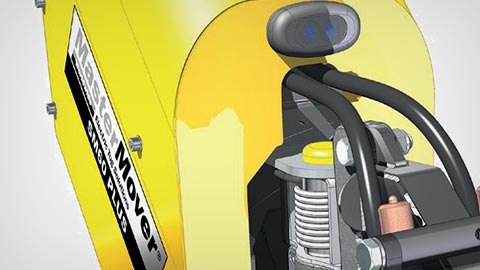3D Design Solution supports efficiency and business growth at MasterMover
3D Design Solution supports efficiency and business growth at MasterMover

Case Study
Materials handling company uses Solid Edge to define a new class of product and develop a worldwide market
MasterMover
Siemens Digital Industries Software solution supports efficiency and business growth at MasterMover
With a MasterMover electric tug, a single pedestrian operator can safely, efficiently and cost-effectively move a load weighing up to 120 metric tons. As companies take advantage of this powerful yet compact means of handling materials, MasterMover electric tugs can be found in factories, warehouses, laboratories and retail stores around the world. JCB, Airbus, General Electric, Tesco and the National Health Service are all customers of MasterMover, based near Derby in the United Kingdom.
Formed in 1997, the company set out to provide a retail industry solution for moving multiple cages around supermarkets. It developed a unit that removed the effort and danger associated with moving wheeled loads by using a leveraged weight transfer system and a powerful electric motor. This unit could be adapted to any customer’s needs, and MasterMover soon found that it was responding to demand from many industries. Since then, it has grown a completely new market with an extensive range of adaptable designs. These are all created using Solid Edge® software from product lifecycle management (PLM) specialist Siemens Digital Industries Software. The 3D design solution enables the company to re-use design data, streamline communication within the company and support sales and customer service. “By underpinning our sales process and reducing development time, Solid Edge is intrinsic to the company’s success,” says Andy Owen, managing director at MasterMover.
Speed, quality and customer service through re-use of design data
One key aim for MasterMover was to bring more structure to the business by creating full traceability. In particular, the company wanted to leverage elements of the many customized solutions it had delivered over the years. “What we originally had was a drawing system that was independent of everything else,” explains Owen. “It made it very difficult for any individual to know exactly what we had done in the past, which meant that we often duplicated designs.”
The design department used Solid Edge to create a logical numbering method for all components and subcomponents. In combination with a searchable and filterable database, the design, sales, stock and service functions all employ exactly the same identification codes.
According to Owen, traceability is key to quality and service; for example, a customer may want a unique coupling and then request a revision further down the line. In addition, traceability saves huge amounts of time. “The speed with which we can now develop comes from our ability to change and re-use data, and Solid Edge was the catalyst for this,” comments Owen. “Everything comes from the drawings. If we need to trace a part number from a sales invoice or Bill of Materials, we can do so in an instant. Before, this process could take days.”
